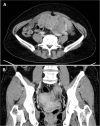1. Kasper DL, Fauci AS, Hauser SL, Longo DL, Jameson JL, Braunwald E, editors. Harrison's principles of internal medicine. New York: Mc Graw Hill education; 2015.
3. Center N cancer. Annual Report of Cancer Statistics in Korea in 2015. 2017.
5. Acheson ED, Gardner MJ, Pippard EC, Grime LP. Mortality of two groups of women who manufactured gas masks from chrysotile and crocidolite asbestos: a 40-year follow-up. Br J Ind Med. 1982; 39(4):344–348. DOI:
10.1136/oem.39.4.344. PMID:
6291580.

7. Heller DS, Gordon RE, Katz N. Correlation of asbestos fiber burdens in fallopian tubes and ovarian tissue. Am J Obstet Gynecol. 1999; 181(2):346–347. DOI:
10.1016/S0002-9378(99)70559-4. PMID:
10454680.

9. Reid A, de Klerk N, Musk AW. Does exposure to Asbestos cause ovarian Cancer? A systematic literature review and meta-analysis. Cancer Epidemiol Biomark Prev. 2011; 20(7):1287–1295. DOI:
10.1158/1055-9965.EPI-10-1302.

10. IARC. IARC Monographs on the Evaluation of Carcinogenic Risks to Humans: Arsenic, Metals, Fibres, and Dusts. 2012;100.
11. Takeshima Y, Amatya VJ, Kushitani K, Inai K. A useful antibody panel for differential diagnosis between peritoneal mesothelioma and ovarian serous carcinoma in Japanese cases. Am J Clin Pathol. 2008; 130(5):771–779. DOI:
10.1309/AJCPHSUJ15NEYMIP. PMID:
18854270.

12. Camargo MC, Stayne LT, Straif K, et al. Occupational exposure to asbestos and ovarian cancer: a meta-analysis. Environ Health Perspect. 2011; 119(9):1211–1217. DOI:
10.1289/ehp.1003283. PMID:
21642044.

13. Ferrante D, Chellini E, Merler E, et al. Italian pool of asbestos workers cohorts: mortality trends of asbestos-related neoplasms after long time since first exposure. Occup Environ Med. 2017; 74(12):887–898. DOI:
10.1136/oemed-2016-104100. PMID:
28775133.

14. Oddone E, Ferrante D, Tunesi S, Magnani C. Mortality in asbestos cement workers in Pavia, Italy: a cohort study. Am J Ind Med. 2017; 60(10):852–866. DOI:
10.1002/ajim.22750. PMID:
28833303.

15. Oh SM, Shin YK, Park DY, Park DUCK. A study on worker exposure level and variation to asbestos in some asbestos industires. Korean Ind Hyg Assoc J. 1993; 3(1):100–109.
16. Park JI, Yoon CSPN. A study on exposure among asbestos textile workers and estimation of their historical exposures. Korean Ind Hyg Assoc J. 1995; 5(1):16–39.
17. Park DYPN. Worker exposure to asbestos fibers in asbestos slate manufacturing and asbestos textile industries. Korean J Env Heal Soc. 1988; 14(2):13–27.
18. Science NI of L. Investigation of Harmful Environment of Workplace, Annunal Report No. 23. 1984.
19. Science NI of L. Survey on Health Status of Asbestos Handling Workplace, Annual report no. 49. 1987.
20. Yun I, Park C, Lee W, Lim YKK. Epidemiological survey on environment and health status in asbestos factories. Kor J Occup Med. 1993; 5:137–151.
22. Pira E, Pelucchi C, Buffoni L, et al. Cancer mortality in a cohort of asbestos textile workers. Br J Cancer. 2005; 92(3):580–586. DOI:
10.1038/sj.bjc.6602240. PMID:
15702125.

23. Pira E, Romano C, Violante FS, et al. Updated mortality study of a cohort of asbestos textile workers. Cancer Med. 2016; 5(9):2623–2628. DOI:
10.1002/cam4.824. PMID:
27457053.

25. Kang D. Health effects of environmental asbestos exposure. J Env Hlth Sci. 2009; 35(2):71–77.

26. Organization WH, Fibres WHOTG on A and ONM, Safety IP on C, Programme UNE, Organisation IL. Asbestos and other natural mineral fibres. 1986.
27. Michel Camus JSBM. Nonoccupational exposure to chrysotile asbestos and the risk of lung caner. N Engl J Med. 1998; 338(22):1565–1571. DOI:
10.1056/NEJMoa012295.PMID:
9603793.
28. University of Edinburgh RU in H and BC. Changing the Public Health. 1989.
29. Marfels H, Spurny K, Chr B, et al. Measurements of fibrous dusts in ambient air of the Federal Republic of Germany. 1987.
30. Kurumatani N, Kumagai S. Mapping the risk of mesothelioma due to neighborhood asbestos exposure. Am J Respir Crit Care Med. 2008; 178(6):624–629. DOI:
10.1164/rccm.200801-063OC. PMID:
18556631.

31. D K. Estimation of past asbestos exposure-Indonesian field study. Kor Soc Occup Environ Med. 2008. p. 167–168.
32. Burdett GJ, Jaffrey SA. Airborne asbestos concentrations in buildings. Ann Occup Hyg. 1986; 30(2):185–199. PMID:
3752838.
33. Altree-Williams S, Preston JS. Asbestos and other fibre levels in buildings. Ann Occup Hyg. 1985; 29(3):357–363. PMID:
4073703.
34. Bae H, Kang D, Kim Y, et al. Respiratory symptoms , pulmonary function tests , and Asbestos related chest radiograph abnormalities of former Asbestos textile factory workers. Korean J Occup Env Med. 2010; 22(4):331–344.
35. KOSHA. Prevention of Health Disorder by Asbestos II. 2006.
36. Magnani C, Agudo A, González CA, et al. Multicentric study on malignant pleural mesothelioma and non-occupational exposure to asbestos. Br J Cancer. 2000; 83(1):104–111. DOI:
10.1054/bjoc.2000.1161. PMID:
10883677.

37. Kang D-M, Kim J-E, Kim Y-K, Lee H-H, Kim S-Y. Occupational burden of Asbestos-related diseases in Korea, 1998–2013: asbestosis, mesothelioma, lung Cancer, laryngeal Cancer, and ovarian Cancer. J Korean Med Sci. 2018; 33(35):1–9. DOI:
10.3346/jkms.2018.33.e226.

38. Dumortier P, Çoplü L, De Maertelaer V, Emri S, Baris I, De Vuyst P. Assessment of environmental asbestos exposure in Turkey by bronchoalveolar lavage. Am J Respir Crit Care Med. 1998; 158(6):1815–1824. DOI:
10.1164/ajrccm.158.6.9712119. PMID:
9847273.

39. Miserocchi G, Sancini G, Mantegazza F, Chiappino G. Translocation pathways for inhaled asbestos fibers. Environ Heal A Glob Access Sci Source. 2008; 7:1–8. DOI:
10.1186/1476-069X-7-4.

40. Hisanaga N, Sakai K, Iwata M, Ono Y, Shibata ETY. Asbestos fibers in human pulmonary and extrapulmonary tissues. Am J Ind Med. 1988; 14:331–339. DOI:
10.1002/ajim.4700140310. PMID:
3189349.
41. Weiderpass E, Labrèche F. Malignant tumors of the female reproductive system. Saf Health Work. 2012; 3(3):166–180. DOI:
10.5491/SHAW.2012.3.3.166. PMID:
23019529.

42. Kang DM, Gu DC, Kim KH. Asbestos-related diseases among asbestos textile factory workers and residents around the factory. J Korean Med Assoc. 2009; 52(5):482–488. DOI:
10.5124/jkma.2009.52.5.482.

43. Nynäs P, Pukkala E, Vainio H, Oksa P. Cancer incidence in Asbestos-exposed workers: an update on four Finnish cohorts. Saf Health Work. 2017; 8(2):169–174. DOI:
10.1016/j.shaw.2016.11.003. PMID:
28593073.

44. Holley AK, Bakthavatchalu V, Velez-Roman JM, et al. Asbestos, asbestosis, and cancer, the Helsinki criteria for diagnosis and attribution 2014 recommendations. Scand J Work Environ Health. 2015; 41(1):5–15. DOI:
10.5271/sjweh.3462. PMID:
25299403.







 PDF
PDF Citation
Citation Print
Print





 XML Download
XML Download